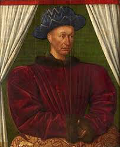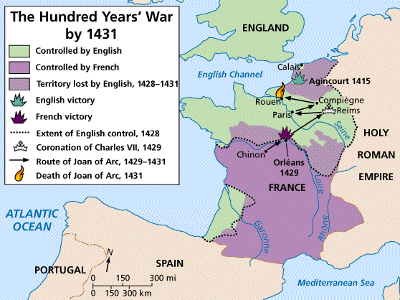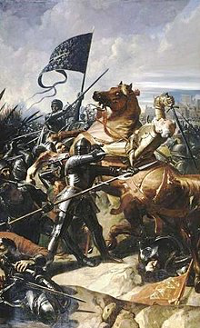The French King Charles VII
Charles VII was King of France in the 15th Century. He was on the throne when France claimed victory in the Hundred Years War. 
He was born on Feb. 22, 1403, in Paris. His father was the reigning monarch, Charles VI. When he was 10, the young Charles found himself betrothed to Marie of Anjou, whose father was Louis II of Anjou, the King of Naples. Charles went to Anjou to live with his soon-to-be wife, then 9, and her parents. In 1416, Charles was captain general of Paris and began to have influence in the royal council. By this time, his father was well into his long struggle with ill mental and physical health. France at this time was at war with both Burgundy and England. The Burgundian war had begun only in 1407; the English struggle, known as the Hundred Years War, had been raging off and on since 1337. Charles fled Paris, in May 1418, when a Burgundian army occupied the capital. He set up a court at Bourges and declared himself regent, with a Parliament at Poitiers. (He had become the heir to the throne a year earlier, when his oldest surviving brother died.) Charles, in an effort to eliminate one enemy, negotiated a pact with John the Fearless, the Duke of Burgundy, in 1419. At a subsequent meeting between the two, however, supporters of Charles killed the duke and then his successor, Philip the Good, threw in his lot with the English. This was the backdrop to the Treaty of Troyes, which Charles V signed with England's King Henry V, resulting in Henry's displacing the young Charles as the Dauphin, the heir to the throne. Both monarchs died in 1422. Charles claimed the French throne, even though his father had technically removed him from the line of succession. England claimed that Henry's infant son, Henry VI, was King of England and King of France. The war continued. In that same year, Charles finally married Marie of Anjou; they had 14 children together. Meanwhile, the young Charles carried on the war as he could, occupying La Charité but avoiding any direct conflict with Burgundy. All sides wearied of the conflict, and negotiations resumed for a time. However, a rejuvenated England continued the fighting, advancing to besiege the strategic city of Orléans in October 1428. 
It was here that one of the most famous names in French history entered the picture. Joan of Arc, a teenage girl claiming to have had religious visions, convinced the Dauphin to allow her to go to Orléans and join the troops defending the city. She succeeded in rallying the troops and led them in turning the tables on the English, taking the fight to them; as a result, the English army broke off the siege. That trend continued, as the suddenly inspired French pursued the retreating English, winning a smashing victory near the village of Patay; in the rout, French troops captured the English commander, John Talbot, 1st Earl of Shrewsbury. The French trend of victory continued, and the Dauphin was crowned Charles VII on July 16, 1429, in Reims. The English followed up with a coronation of their own, crowning the infant heir Henry VI on November 5, 1429. Illustrating just how much French territory England controlled at this late state, Henry VI was also crowned king of France on Dec. 16, 1431. In between Henry's two coronations, England's Burgundian allies captured Joan of Arc, at the siege of Compiègne on May 23, 1431, and sent her to English forces, who quickly tried and convicted her of heresy. She was burned at the stake a week later. 
As when she arrived on the scene, Joan of Arc cast a long shadow after her death. The English king was still too young to rule in a meaningful way, and so the decisions continued to be left to his advisors, who disagreed on how to proceed. England and France met for negotiations at Arras in 1435 but couldn't agree on terms and so no peace was made. In fact, one of England's key allies–Philip III, duke of Burgundy–changed sides and handed Paris over to Charles VII. England and France had achieved a brief truce in 1444, and Henry VI had married the French princess Margaret of Anjou on April 23, 1445, at Titchfield Abbey. England broke the fragile truce four years later by sacking lands in Brittany.
The length of the war began to take its toll on English fortunes. France continued to have superior numbers and to have the advantage of fighting on and for home soil. As well, the new French king made the most of his father's ambitions to develop a modernized army, spearheaded by the advent of the dominance of French artillery. What started out as an army add-on became, during the course of the war, a difference-maker in pitched field battles and in sieges. This resulted in the first regular standing army in Western Europe since the end of the Roman Empire, about a century earlier. French advances continued. France retook Rouen and consolidated its hold on Normandy. France besieged the Gascony capital, Bordeaux, on June 30, 1451, only to lose it the following October. Another French victory followed, at the Battle of Castillon (right), in July of 1453. That was officially the last battle of the war. England still controlled Calais, but that was the extent of its French possessions. The end of the long war with the English did not bring immediate peace. Philip, Duke of Burgundy still considered more of an appropriate ruler of France than Charles. As well, Louis, the Dauphin and Charles's oldest son, had designs of his own on the crown, early. Historians refer to Charles as Charles the Victorious (for winning the war). His establishment of a standing army played a large part in the eventual victory. He also strengthened the influence of the throne across the land, rallying his countrymen and countrywomen around the monarch in his struggle against invasion from two sides. As well, Charles returned France to a sound economic footing in the waning decades of the war, largely through following the actions of advisers like his financial wizard Jacques Coeur. Charles became seriously ill in 1458 and lingered near death for a time. He died on July 22, 1461, at Mehun-sur-Yèvre. He and the Dauphin were estranged at the time, not the least because son had plotted against father and father had sent son into exile. When Charles died, Louis took the throne, becoming King Louis XI. |
|
Social Studies for Kids
copyright 2002–2026
David White





